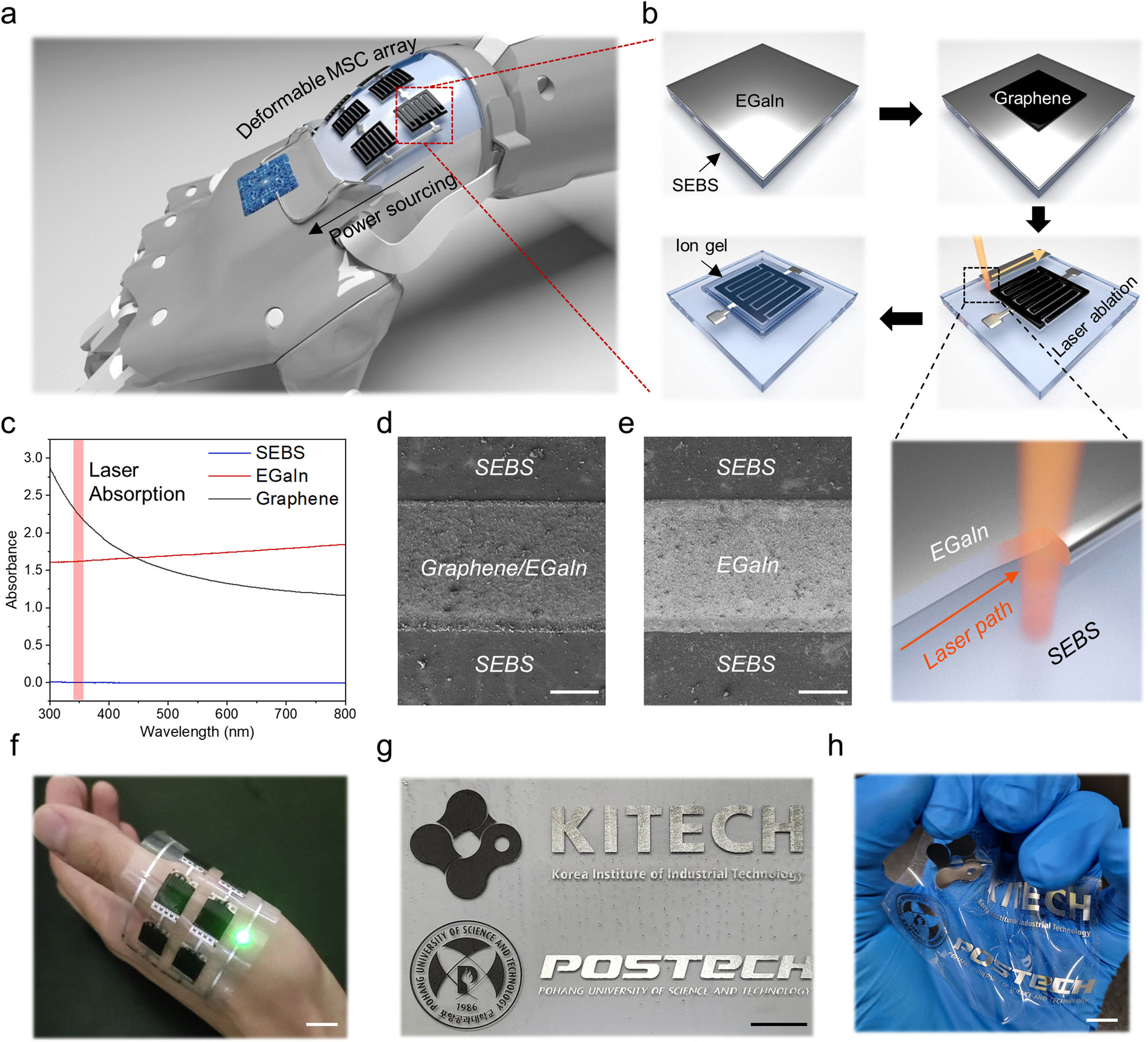| Mar 18, 2024 |
|
|
|
(Nanowerk Spotlight) The advent of wearable technology has brought with it a pressing need for energy storage solutions that can keep pace with the flexibility and stretchability of soft electronic devices. Conventional rigid batteries and supercapacitors have proven inadequate for seamless integration into wearables that must conform to the human body and withstand the strain of daily use. This mismatch between energy storage and device flexibility has hindered progress in fields such as health monitoring, smart textiles, and biomedical implants.
|
|
Micro-supercapacitors (MSCs) have emerged as a promising candidate for deformable energy storage, thanks to their high-power density, rapid charging, and long cycle life. However, creating the intricate interdigitated electrode patterns necessary for high-performance MSCs using materials that can endure repeated stretching and twisting has proven challenging. While researchers have made strides in enhancing flexibility through inventive patterning and elastic substrates, many approaches require complex fabrication and still fail under extreme deformation.
|
|
Now, a collaborative research effort led by Dr. Chanwoo Yang from the Korea Institute of Industrial Technology and Professor Jin Kon Kim from Pohang University of Science and Technology, has yielded a potential solution. In their paper published in npj Flexible Electronics (“Deformable micro-supercapacitor fabricated via laser ablation patterning of Graphene/liquid metal”), the team details the fabrication of highly deformable graphene based MSCs using liquid metal current collectors on an elastic polymer substrate.
|
 |
| a Illustration of an integrated system comprising soft-electronics and deformable energy storage component. b The fabrication process of EGaIn-based MSC. c UV-vis spectra of SEBS, EGaIn, and graphene. FE-SEM images of laser ablated d Graphene/EGaIn and e EGaIn (Scale bar = 200 µm). Photographs of f institute logos, g deformed logos, and h an LED connected to the MSC circuit (Scale bar = 1 cm). (Image: © npj Flexible Electronics)
|
|
The key innovation lies in the use of eutectic gallium-indium (EGaIn), a liquid metal alloy, as the current collector. “To implement a deformable MSC, a deformable current collector is needed,” Kim explains to Nanowerk. “However, the commonly used current collectors are made of brittle materials like gold (Au). To address this issue, we have chosen ‘liquid metal’ that inherently possesses the properties of a liquid and metallic conductivity.”
|
|
The fabrication process begins with coating a thin film of EGaIn onto a stretchable styrene-ethylene-butylene-styrene (SEBS) substrate, followed by the deposition of a graphene layer to serve as the active electrode material. The researchers selectively ablate graphene and EGaIn to obtain interdigitated pattern by using laser, exploiting the strong laser absorption of these materials compared to the transparent SEBS. By carefully tuning the laser intensity, they achieve precise patterning without damaging the underlying elastic substrate.
|
|
The choice of materials proves crucial to the success of this approach. “We successfully achieved patterning of the liquid metal by utilizing its excellent absorption of the laser’s wavelength,” notes Kim. “Furthermore, by adjusting the intensity of the laser, we prevented the damage to the substrate caused by the heat induced by laser, whereas both the graphene and liquid metal were ablated by the laser.”
|
|
The SEBS substrate, which does not absorb the laser wavelength, can withstand the heat generated during ablation, allowing for the creation of high-resolution patterns with electrode gaps as small as 90 µm.
|
|
The resulting MSCs exhibit impressive performance, achieving areal capacitances up to 1336 µF cm-2 while maintaining good rate capability. Importantly, the devices show no significant degradation under various mechanical deformations, including folding, wrinkling, twisting, and stretching, even after 1000 deformation cycles.
|
|
“MSC using a liquid metal current collector showed no change in energy storage performance under various mechanical deformations and even after repeated deformations,” emphasizes Kim, highlighting the potential for these devices to power wearable and flexible electronics.
|
|
To demonstrate the practical potential of their MSCs, the researchers integrated an array of devices with light-emitting diodes to create a stretchable lighting system. The system maintained stable operation under severe bending, twisting, and stretching, showcasing the MSCs’ ability to reliably power deformable electronics.
|
|
Looking ahead, Kim and Yang see room for further improvement and exciting possibilities for future applications. “In the field of MSCs, simultaneously achieving high energy density and high deformability remains a significant challenge,” They note. “This is because, during mechanical deformation, not only the interface between the current collector and the active material should be well maintained, but also the energy density of the active materials itself must be increased. Therefore, this issue should be resolved.”
|
|
While additional work is needed to enhance the mechanical durability of the gel electrolyte used in these MSCs, the use of laser-patterned liquid metal electrodes represents a significant step forward in the development of truly deformable energy storage solutions. As wearable technologies continue to advance, innovations like these will play a vital role in ensuring that our devices can adapt to the demands of our dynamic lifestyles.
|
|
From smart clothing that monitors our health to biomedical implants that flex with our bodies, the future of wearable electronics will rely on energy storage systems that are not only compact and powerful but also as flexible as we are. With their unique combination of liquid metal conductors, elastic substrates, and high electrochemical performance, the graphene based MSCs offer an exciting glimpse into that future, stretching the boundaries of what’s possible in wearable energy storage. As research in this field progresses, we can look forward to a new generation of wearable devices that seamlessly integrate with our lives, empowered by deformable energy storage solutions that never hold us back.
|
|

By
Michael
Berger
– Michael is author of three books by the Royal Society of Chemistry:
Nano-Society: Pushing the Boundaries of Technology,
Nanotechnology: The Future is Tiny, and
Nanoengineering: The Skills and Tools Making Technology Invisible
Copyright ©
Nanowerk LLC
|
|
|
- SEO Powered Content & PR Distribution. Get Amplified Today.
- PlatoData.Network Vertical Generative Ai. Empower Yourself. Access Here.
- PlatoAiStream. Web3 Intelligence. Knowledge Amplified. Access Here.
- PlatoESG. Carbon, CleanTech, Energy, Environment, Solar, Waste Management. Access Here.
- PlatoHealth. Biotech and Clinical Trials Intelligence. Access Here.
- Source: https://www.nanowerk.com/spotlight/spotid=64866.php





